Artificial Intelligence (AI) has transformed the technology landscape and reshaped various industries. However, one of the most critical issues we face in this field is the phenomenon of biases in artificial intelligence. In this article, we will explore in depth what biases are, their types, their causes, and how they can affect the outcomes of artificial intelligence systems.
What Are Biases in Artificial Intelligence?
Biases in artificial intelligence refer to the tendency of algorithms and models to produce systematically erroneous results due to prejudices in the data or the design of the system. These biases can lead to unfair, discriminatory, or inaccurate decisions, which have significant implications in applications such as facial recognition, hiring, credit assessment, and criminal justice.
Types of Biases in Artificial Intelligence
There are various types of biases in artificial intelligence that can influence the performance and reliability of systems. Below are the most common ones.
1. Selection Bias
Selection bias occurs when the data used to train a model is not representative of the general population. This can be due to a small or non-random sample, leading to a model that favors one group over another.
2. Exclusion Bias
This type of bias happens when certain features or categories of data are excluded from the model's training. For example, a facial recognition system that does not include enough examples of people from different ethnicities may be ineffective for these populations.
3. Measurement Bias
Measurement bias occurs when the collected data is somehow contaminated. For instance, if a credit scoring system uses data that includes errors or outdated information, it can result in an unfair assessment.
4. Confirmation Bias
This bias refers to the tendency of an artificial intelligence model to reinforce pre-existing beliefs, ignoring data that may contradict those judgments. This can highlight existing inequalities in society.
Causes of Biases in Artificial Intelligence
Several factors can contribute to the emergence of biases in artificial intelligence systems:
1. Unequal Data
The datasets used to train AI models may reflect historical or social inequalities, leading to inherent bias in the results. For example, if a training dataset for a recruitment system includes a low number of women, the model may favor men.
2. Lack of Diversity in Design
The teams designing and developing artificial intelligence systems often lack diversity, which can result in a lack of perspectives and, consequently, the development of products that do not account for all variations of the population.
3. Algorithm Errors
The algorithms themselves can contain biases that are introduced deliberately or accidentally. This may occur due to inappropriate programming or poorly informed decisions in the design logic.
Impact of Biases in Artificial Intelligence
Biases in artificial intelligence can have serious and far-reaching consequences. Here are some areas where the impact is evident:
1. Employment Discrimination
AI-based recruitment systems that do not achieve equitable representation of demographic groups can perpetuate discrimination in the workplace. This can lead to the exclusion of qualified candidates based on their gender, race, or background.
2. Criminal Justice Systems
The use of AI in criminal justice systems can result in the overcriminalization of certain groups, as algorithms may be biased toward historical information that favors some groups over others. This practice can lead to disproportionate sentencing.
3. Targeted Advertising
Advertising systems that use artificial intelligence may perpetuate biases by showing different ads to different demographic groups. This can affect purchasing decisions and the availability of opportunities based on one's social group.
How to Mitigate Biases in Artificial Intelligence?
Mitigating biases in artificial intelligence is crucial for promoting transparency and fairness. Here are some strategies that can be implemented:
1. Data Diversification
Ensuring that datasets are representative and equitable can help reduce bias. This includes collecting data from a wide range of sources and demographic groups.
2. Continuous Evaluation and Validation
Conducting regular audits and rigorous testing can help identify and correct biases before artificial intelligence systems are deployed in real-world settings.
3. Promoting Diversity in Teams
Encouraging diversity in AI development teams can lead to more thoughtful design that is aware of potential biases, ultimately enhancing the effectiveness and fairness of the systems.
4. Transparency in Algorithms
Creating algorithms that are understandable and allow for bias identification will help developers and users better understand how decisions are made.
Conclusion
Biases in artificial intelligence represent a significant challenge that can affect fairness and accuracy in various domains. It is essential that both developers and organizations implementing AI are aware of these biases and actively work to mitigate them. By doing so, we can move towards a future in which artificial intelligence contributes equitably to the well-being of society as a whole.
Remember that addressing biases in artificial intelligence is an ongoing journey, and it is the responsibility of everyone involved in the AI field to contribute to positive change.




















